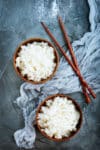This easy white rice recipe will show you how to make White Rice on the stove. It’s simple, delicious, and satisfying!
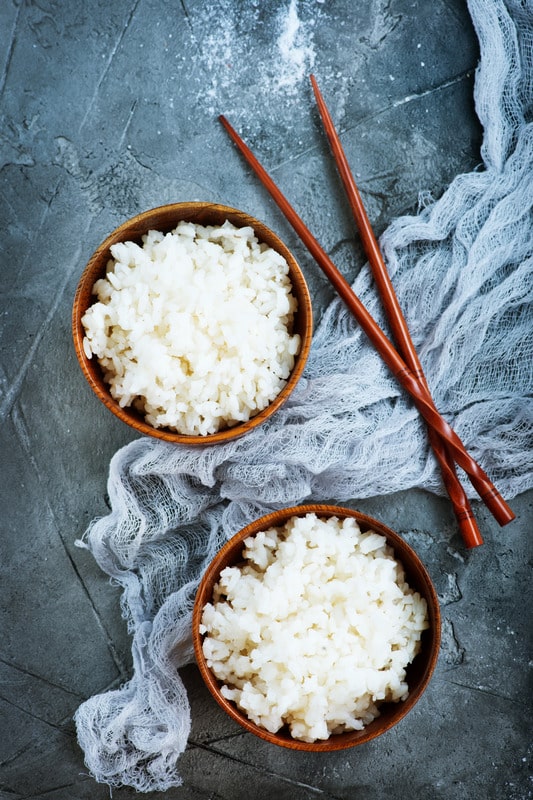
This recipe for white rice yields perfectly cooked, fluffy grains or rice that pair harmoniously with all your favorite dishes. You can use this method to cook short, medium, or long-grain white rice. It’s so simple.
Ingredients for White Rice
This recipe is 2-ingredient simple. You only need rice, water, a medium saucepan [paid link] with a lid, and a stove. No special appliances are needed to make perfectly fluffy white rice each and every time.
- Rice: In many rice-based dishes, rice serves as the primary ingredient. Its texture, flavor, and cooking method greatly impact the final outcome of the dish.
- Water: Water is the primary cooking medium for rice. It helps rice grains absorb moisture, soften, and expand during cooking, resulting in the desired texture. Proper measurement and control of water ensure that rice doesn’t turn out undercooked (hard) or overcooked (mushy).
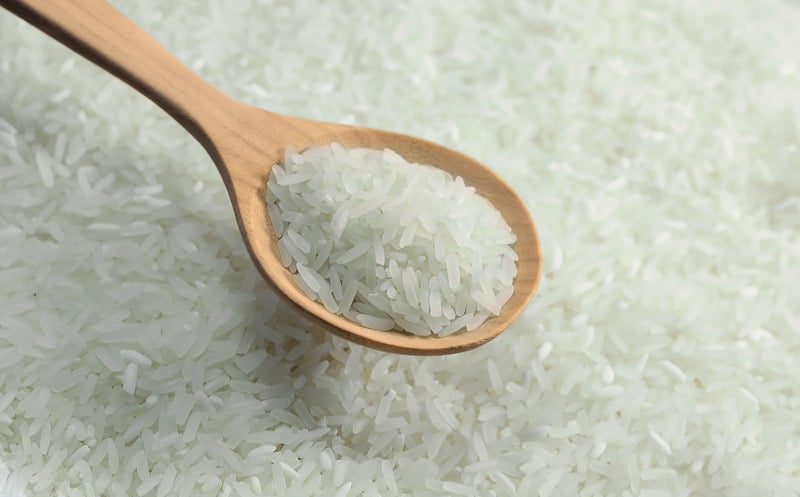
How to Make White Rice on the Stove Top
With these steps, you can make perfectly cooked white rice on the stovetop. Enjoy your rice with various dishes.
- Rinse the Rice (optional): Rinse the rice in a fine-mesh sieve under cold water until the water runs clear. This helps remove excess starch and prevents the rice from being too sticky. Skip this step if you prefer stickier rice.
- Combine Rice and Water: In a saucepan [paid link], combine the rinsed rice and water.
- Bring to a Boil: Place the saucepan [paid link] on the stove over high heat and bring the water to a rolling boil.
- Simmer: Once boiling, reduce the heat to low to maintain a gentle simmer. Cover the saucepan [paid link] with a tight-fitting lid.
- Cook: Let the rice simmer for about 18-20 minutes (or according to package instructions), without removing the lid. Cooking times may vary slightly depending on the type of rice you’re using, so refer to the package instructions for precise timing.
- Check for Doneness: After the recommended cooking time, turn off the heat, and let the rice sit, covered, for 5-10 minutes. This allows the steam to finish cooking the rice and makes it fluffier.
- Fluff and Serve: After resting, uncover the saucepan [paid link] and use a fork to gently fluff the rice. Serve it as a side dish, with your favorite sauce or toppings, or as a base for other dishes.
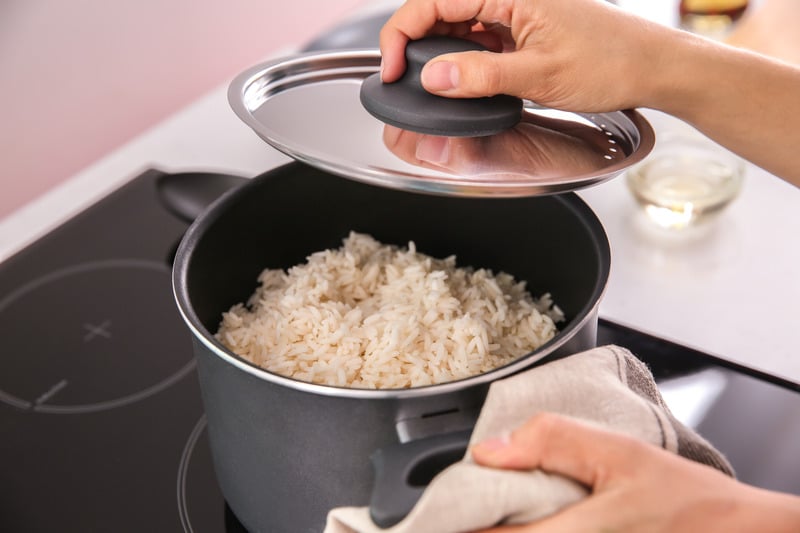
Why this Recipe Works:
This stovetop white rice recipe works because it follows key principles of rice cooking to ensure perfect results:
- Proper Rice-to-Water Ratio: The 2:1 ratio of water to rice is a fundamental rule for white rice. It ensures that the rice absorbs just the right amount of moisture to become tender without being overly wet or dry.
- Bringing to a Boil: Starting with high heat to bring the water to a boil helps activate the cooking process quickly and evenly. This initial high heat is essential for cooking rice thoroughly.
- Simmering with a Lid: Simmering the rice with a tightly covered lid allows the steam to circulate within the pot, cooking the rice evenly. The lid traps the steam, creating the right conditions for perfectly cooked rice.
- Resting Period: Allowing the rice to sit off the heat, still covered, for a few minutes after cooking lets it absorb any remaining steam and finish cooking through. This step contributes to the desired fluffiness and separation of grains.
- Fluffing with a Fork: Gently fluffing the rice with a fork after it has rested separates the grains and prevents clumping. This final step ensures that the rice is light and fluffy, and ready to be served.
By adhering to these key steps, this stovetop white rice recipe consistently produces rice with the ideal texture, flavor, and consistency, making it a reliable and versatile staple for various culinary creations.
Recipe Tips and Kitchen Tricks:
- Here are some recipe tips and kitchen tricks to enhance your white rice cooking experience:
- Use Quality Rice: Start with good-quality white rice, such as long-grain, jasmine, or basmati, for the best flavor and texture.
- Rinse the Rice: Rinsing the rice under cold water before cooking can remove excess starch and prevent it from becoming too sticky. However, skip this step if you prefer stickier rice.
- Flavor Variations: Experiment with flavor by using broth instead of water, and adding herbs, spices, or aromatics (like garlic or ginger) to the cooking liquid for a fragrant twist.
- Butter or Oil: Adding a small amount of butter or oil when cooking the rice can enhance its flavor and make it slightly richer. This is optional but can be quite delicious.
- Toast the Rice (Optional): Before adding water, you can briefly toast the rice in a little oil or butter to enhance its nutty flavor. Be careful not to burn it.
- Don’t Peek: Once you’ve covered the rice and reduced the heat to simmer, resist the urge to lift the lid and check on it. Keeping the lid closed ensures that the steam stays trapped, which is crucial for even cooking.
Recipe Variations:
- White rice is a versatile ingredient that can be customized in various ways to suit different cuisines and flavors. Here are some popular recipe variations:
- Fried Rice: Transform plain white rice into a flavorful and satisfying dish by making fried rice. Sauté cooked rice with vegetables, proteins like chicken, shrimp, or tofu, and a savory sauce mixture. Add soy sauce, garlic, ginger, and your choice of seasonings for an Asian-inspired delight.
- Coconut Rice: Elevate your rice with a tropical twist by making coconut rice. Cook white rice in coconut milk instead of water and add a pinch of salt and a touch of sugar for sweetness. It pairs beautifully with Thai or Caribbean dishes.
- Pilaf: Create a rice pilaf by sautéing rice with onions and garlic in butter or oil before adding the cooking liquid. You can also add diced vegetables, nuts, or raisins for added flavor and texture.
- Spanish Rice: For a Spanish-inspired dish, make Spanish rice by sautéing rice with onions, bell peppers, and tomatoes. Season with paprika, cumin, and chili powder for a flavorful side dish.
- Sushi Rice: Sushi rice is specially seasoned with rice vinegar, sugar, and salt. Use this seasoned white rice to make sushi rolls or sushi bowls.
- Lemon Rice: Add a zesty kick by mixing cooked white rice with lemon juice, lemon zest, and fresh herbs like parsley or cilantro. Lemon rice pairs well with grilled chicken or seafood.
- Risotto: Create a creamy and comforting risotto by cooking white rice slowly in a flavorful broth.
- Cilantro-Lime Rice: For a Mexican-inspired side, cook white rice with fresh cilantro and lime juice. It’s an excellent accompaniment to tacos, burritos, or fajitas.
- Vegetable Rice: Enhance the flavor of your rice by adding fresh vegetables for a delicious vegetable rice.
Serving Suggestions:
White rice is a versatile and neutral base that can be paired with a wide range of dishes and flavors. Here are some serving suggestions to make the most of your white rice:
- Stir-Fries: Serve white rice with your favorite stir-fry recipes, such as chicken and broccoli, beef and vegetables, or tofu with mixed vegetables. The rice absorbs the savory sauces and complements the stir-fried ingredients.
- Curries: Pair white rice with a variety of curries, including Indian, Thai, or curry. The mildness of white rice balances the bold flavors of the curry sauces.
- Seafood Dishes: Serve white rice with seafood dishes like shrimp scampi, lemon butter salmon, or seafood paella. The rice can soak up the delicious seafood juices and flavors.
- Mediterranean Cuisine: Serve white rice with Mediterranean dishes like Greek meatballs, gyros, or lemon chicken. It pairs well with tzatziki sauce and Mediterranean salads.
- Soups and Stews: Use white rice as a side dish for hearty soups and stews. It’s especially good with chicken noodle soup or a flavorful Chicken gumbo.
- Sauces and Gravies: Serve white rice as a side with rich sauces and gravies, like beef stroganoff.
- Poke Bowls: Create your own poke bowl by topping white rice with fresh fish or tofu, assorted vegetables, and flavorful sauces.
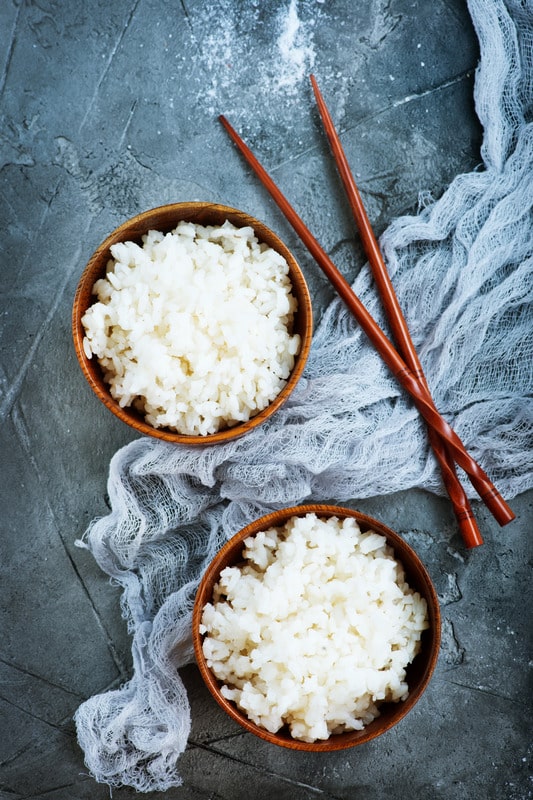
Storing, freezing, and reheating instructions
Storing, freezing, and reheating white rice properly is essential to maintain its quality and safety. Here are instructions for each:
Storing White Rice:
- Refrigeration: Store cooked white rice in an airtight container or a resealable plastic bag in the refrigerator. Make sure it’s completely cool before sealing the container. Properly stored, it can stay fresh for up to 4-6 days.
- Avoid Overcrowding: Divide the rice into smaller portions if you have a large batch. This helps it cool down faster and prevents the growth of bacteria.
Freezing White Rice:
- Cooling: Let the cooked rice cool to room temperature first, or refrigerate it for a few hours before freezing.
- Portioning: Divide the rice into individual portions or the desired serving sizes. This makes it easier to thaw and reheat later without having to defrost the entire batch.
- Wrap and Seal: Place each portion in an airtight freezer-safe container, a heavy-duty resealable plastic bag, or wrap it tightly in plastic wrap and aluminum foil to prevent freezer burn.
- Label: Don’t forget to label the containers or bags with the date so you can keep track of how long they’ve been in the freezer.
Reheating Frozen White Rice:
- Thawing: If the rice is in individual portions, you can thaw it in the refrigerator overnight. Alternatively, use the defrost function on your microwave.
- Microwave Method: Place the thawed rice in a microwave-safe dish, add a small amount of water to prevent drying out (a few tablespoons), cover with a microwave-safe lid or plastic wrap, and heat in 1-minute intervals, fluffing with a fork in between until it’s heated through.
- Stovetop Method: Heat a small amount of oil or butter in a pan, add the thawed rice, and stir-fry over medium heat until it’s heated through and slightly crispy on the edges. You can also add a few drops of water to steam it.
- Steaming Method: Place the thawed rice in a steamer or a heatproof bowl over boiling water. Steam for a few minutes until it’s heated through.
- Avoid Refreezing: Once you’ve thawed and reheated the rice, it’s not recommended to refreeze it.
Frequently Asked Questions (FAQs)
- What’s the difference between white rice and brown rice?
- White rice has had the bran and germ layers removed, while brown rice retains these layers. This makes white rice cook faster but removes some of the nutrients and fiber found in brown rice.
- How do I make my white rice less sticky?
- Rinsing the rice before cooking can help reduce stickiness. Using the correct rice-to-water ratio and fluffing the rice with a fork after cooking also helps.
- Can I reheat white rice in the microwave?
- Yes, you can reheat white rice in the microwave. Add a small amount of water to prevent it from drying out and heat in 1-minute intervals, fluffing with a fork in between.
- Is white rice gluten-free?
- Yes, white rice is naturally gluten-free, making it suitable for those with gluten sensitivities or celiac disease.
Wine & Cocktail Pairings
Remember, personal preferences play a role, so feel free to explore and discover your own favorite pairings!
Wine Pairings:
- Chardonnay: Chardonnay, with its buttery and oaky notes, complements creamy rice-based dishes like risotto or a rich mushroom risotto. Its acidity also balances the richness of the dish.
- Sauvignon Blanc: A crisp and refreshing Sauvignon Blanc pairs well with lighter white rice dishes, such as seafood fried rice or lemon herb rice. Its bright acidity and citrusy flavors enhance the meal.
- Riesling: The sweetness and acidity of Riesling make it a great match for spicy white rice dishes like Thai green curry with jasmine rice. The sweetness counteracts the heat, and the acidity refreshes the palate.
Cocktail Pairings:
- Mojito: The minty freshness and zesty lime in a Mojito complement the flavors of cilantro-lime rice, making it an excellent pairing for Mexican-inspired dishes.
- Sake Martini: A Sake Martini made with dry sake and a splash of vermouth is a sophisticated choice to pair with sushi or sashimi served with seasoned sushi rice.
- Gin and Tonic: The botanicals in gin and the effervescence of tonic water contrast nicely with the subtle flavors of plain white rice, making it a refreshing pairing for a variety of rice-based dishes.

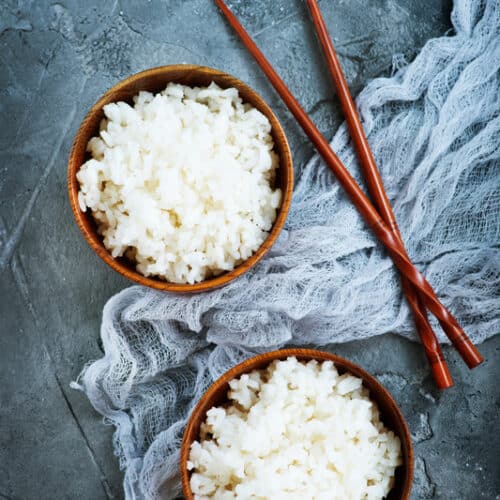
White Rice Recipe
Equipment
- Stove
Ingredients
- 1 cup white rice
- 2 cups water
Optional Ingredients
- salt to taste
- 1 tbsp butter or oil
Instructions
- Rinse the Rice (optional): Rinse the rice in a fine-mesh sieve under cold water until the water runs clear. This helps remove excess starch and prevents the rice from being too sticky. Skip this step if you prefer stickier rice.
- Simmer: Once boiling, reduce the heat to low to maintain a gentle simmer. Cover the saucepan [paid link] with a tight-fitting lid.
- Cook: Let the rice simmer for about 18-20 minutes (or according to package instructions), without removing the lid. Cooking times may vary slightly depending on the type of rice you're using, so refer to the package instructions for precise timing.
- Check for Doneness: After the recommended cooking time, turn off the heat, and let the rice sit, covered, for 5-10 minutes. This allows the steam to finish cooking the rice and makes it fluffier.
- Fluff and Serve: After resting, uncover the saucepan [paid link] and use a fork to gently fluff the rice. Serve it as a side dish, with your favorite sauce or toppings, or as a base for other dishes.
